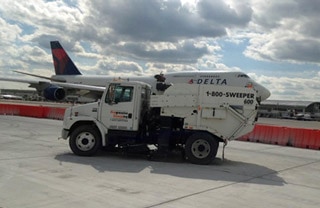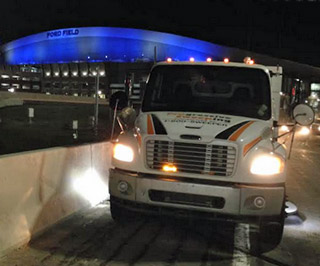Keeping waterways clean and limiting airborne dust disturbed during construction may not initially seem like an area of attention for companies known for maintaining parking lots and sweeping municipal streets. Yet, many consider street sweeping to be the final line of defense keeping eroding and tracked soil and sediment off roads and out of storm water drainage systems. Our power broom sweeping and vacuum sweeping expertise is identified as one of the Best Management Practices (BMPs) for builders to carry out in connection with a qualified sediment and erosion control plan.
Water runoff that carries eroded silt, sand, and soil from construction sites can overtax storm sewer systems as well as harm rivers, lakes, and coastal waters. The Federal EPA has developed rules to task home builders and other construction companies with developing and then maintaining a Stormwater Pollution Prevention Plan (SWPPP) that recognizes and addresses erosion control.
A SWPPP however is more than just a sediment and erosion control plan. The SWPPP document describes all of the construction site operator’s activities to prevent stormwater contamination, control sedimentation and erosion, and comply with the requirements of the Clean Water Act. In larger construction companies, it is common to have a person on staff responsible for erosion and sediment control and stormwater management.
Although the EPA establishes a national standard definition, construction companies may come under the jurisdiction of a state, county, or even local stormwater anti-pollution regulations.
Same Approach – Different Names
Different state or regional Environmental Protection Agencies may reference a SWPPP as:
- Construction Best Practices Plan
- Sediment and Stormwater Plan
- Erosion, Sediment, and Pollution Prevention Plan
- Construction Site Best Management Practices Plan
- Erosion Control Plan and Best Management Practices
- Best Management Practices Plan
- Erosion and Sediment Control Plan
Regardless of the title used in your state, these documents and associated stormwater permits required at active construction sites tend to have a number of common components. 1-800-SWEEPER’s role as our industry’s premier power sweeping service professionals is helping builders specify the most appropriate remediation for dirt tracked out of construction sites and provide the onsite expertise to keep our construction clients in compliance with these regulations.
Professional Erosion Control Certification And Continuing Education
Neither the EPA nor most individual states offer training and certification. However, at the state level, regulations may require construction sites to have a certified individual available or even on-site at all times.
Several programs offer training and certification of individuals in erosion and sediment control. The Soil and Water Conservation Society and the International Erosion Control Association sponsor a national certification program, the Certified Professional in Erosion and Sediment Control (www.cpesc.org.)
As a result of a detailed dialogue at the Sweeper Summit, 1-800-SWEEPER will soon be introducing a program that will offer our Partner companies discounted continuing education, training, and certification through StormwaterOne, a nationally recognized online training organization that specializes in storm water compliance training. Some 1-800-SWEEPER Partners are already certified and available for consultation and assistance in developing plans for construction site sweeping plans. Look for more details on our Stormwater One program in an upcoming news article and vendor partner announcement.
Helping construction companies keep dirt off the roadways and in compliance with the regulations gives all of us a cleaner environment. If you are a construction company that requires road sweeping or storm drain vacuuming to comply with your SWPPP, contact the knowledgeable, helpful construction sweeping vendors at 1-800-SWEEPER today!



